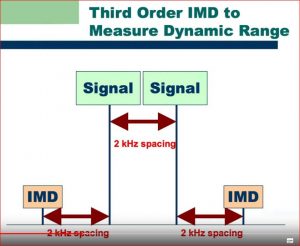In the comment to “HF5L Radio Club in SSB Fieldday 2018” Marek SP5IXS rightly pointed out that “third order dynamic range” is a key parameter of receiver quality. He also asked good questions: What is the difference between IP3 and “3rd order dynamic range”? What is the relationship between RX sensitivity and “3rd order dynamic range”?
As for the “3rd order dynamic range”, the definition, or rather the method of measuring this parameter, was nicely approximated by Rob Sherwood NC0B in his presentation from 2019. For the most frequently used case, “2 kHz 3rd order dynamic range”: two signals with frequencies f1 and f2 (where f2-f1 = 2 kHz) are fed into the receiver. Undesirable mixing products (IMD intermodulation) are produced as a result of the receiver analog path non-linearity. Dominant are the third-order components (2f1-f2) and (2f2-f1), very easy to identify as shown in the figure below.
The level of both signals increases until the distortion reaches the level of the noise floor. This level, after subtracting the background noise, is the “3rd order dynamic range DR3”. For example: noise floor = -128 dBm, test signals = -28 dBm, the dynamic range DR3 = -28 – (-128) = 100 dB. This definition was published in 1975. Briefly – this parameter determines the degradation of the receiver’s properties in the presence of strong signals, i.e. the decrease in its sensitivity to weak signals.
IP3 (hird-order intercept point) is another measure of the same feature, i.e. the receiver’s sensitivity to overdrive as a result of its non-linearity. This is defined even in Wikipedia.
But – as Sławek SP5ICS quoted – from May 2016 you may notice ARRL is no longer publishing third-order intercept point data for receivers. Technology has changed, and most modern receivers do not have a 3:1 ratio between the IMD signal level and the IMD input level. This ratio can be significantly higher or lower than 3:1. Since the IP3 figure is mathematically based on a 3:1 ratio, publication of this data would be meaningless. Instead, pay attention to the three dynamic ranges — IMD, blocking, and reciprocal mixing. The quote comes from the newest review of receivers in QST Magazine.
Like the Sherwood Engineering ranking, the QST Magazine table is based on the value of “2 kHz 3rd-order dynamic range”, which would seem a sufficient argument to consider this parameter as the main measure of the ability to receive weak stations in the presence of interference. So let’s forget about IP3!
However, there is a small “but”. It was noted that sometimes the perceptions of users of the equipment did not coincide with the DR3 ranking. The cause was found in the noise properties of the local generator. In 2012, the definitions of a new indicator called “reciprocal mixing dynamic range” were adopted. The figure below from the NC0B presentation from 2019 shows the meaning of this parameter.
The phase noise of a local generator can be treated as short-term fluctuations in its frequency. If there is a strong signal close to a weak signal, even if it is perfectly “clean”, then when mixed with a noisy local generator, this signal is blurred and distorts the weak signal. This problem concerns to a large extent receivers with a LO generator in the form of frequency synthesizers, especially the older ones. Currently, equipment manufacturers attach great importance to the cleanliness of the local generator. This problem also applies to SDR receivers and its clock, but in this case it is much easier to solve, because a good fixed frequency quartz generator is not a big problem.
Another important measure of receiver quality is “blocking gain compression”, which determines the impact of an adjacent strong signal on the deterioration of reception quality due to gain compression. All of these 3 parameters were well summarized on the slide by Bob AB5N:
BTW it is curious that the differences in position and numerical values between the two rankings are significant. For QST Magazine as of 10/25/2020, No.1 is FTdx5000D, No.2 is (New) FTdx101MP, No.8 is FlexRadio-6600M, No.9 is Elecraft K3S, No.16 is (SDR Icom) IC-7610, No.26 is TS- 590S, No.27 is Perseus, No.32 is IC-7300, and No.45 is FT-991.
Miro SP5GNI




Number of Comments: 1
If the radios were to be compared according to one parameter, the “3rd order dynamic range” seems to be the most appropriate. However, if we expand by other parameters with correspondingly smaller weights to the ranking, it is also important to have a “3rd order dynamic range” for the signal not by 2 kHz, but closer, i.e. in the filter band. Here the impact on the measured parameter will have further parts of the signal path also affecting the listening comfort, not only the “front end”. It also seems sensible to return to the receiver’s sensitivity measurement but not for the signal+noise/noise ratio of 10 dB as it is usually done. Already in the seventies Racal, then the leader in the quality of professional receivers, measured the ratio s+n/n for the signal received 1 microvolt. Such a measurement spoke very much as comfortably, without noise, listens in normal conditions (not in contests), for example in distant seas on ships. Such a measurement pushed down the ranking of the so-called “noise-dynes”. Radio Racal RA 17 from the 1960s had an incredible value for CW – 21 dB.
SP4FR